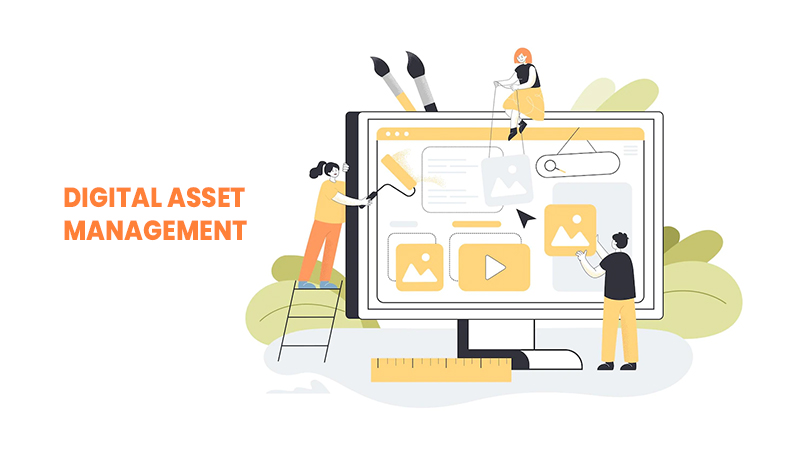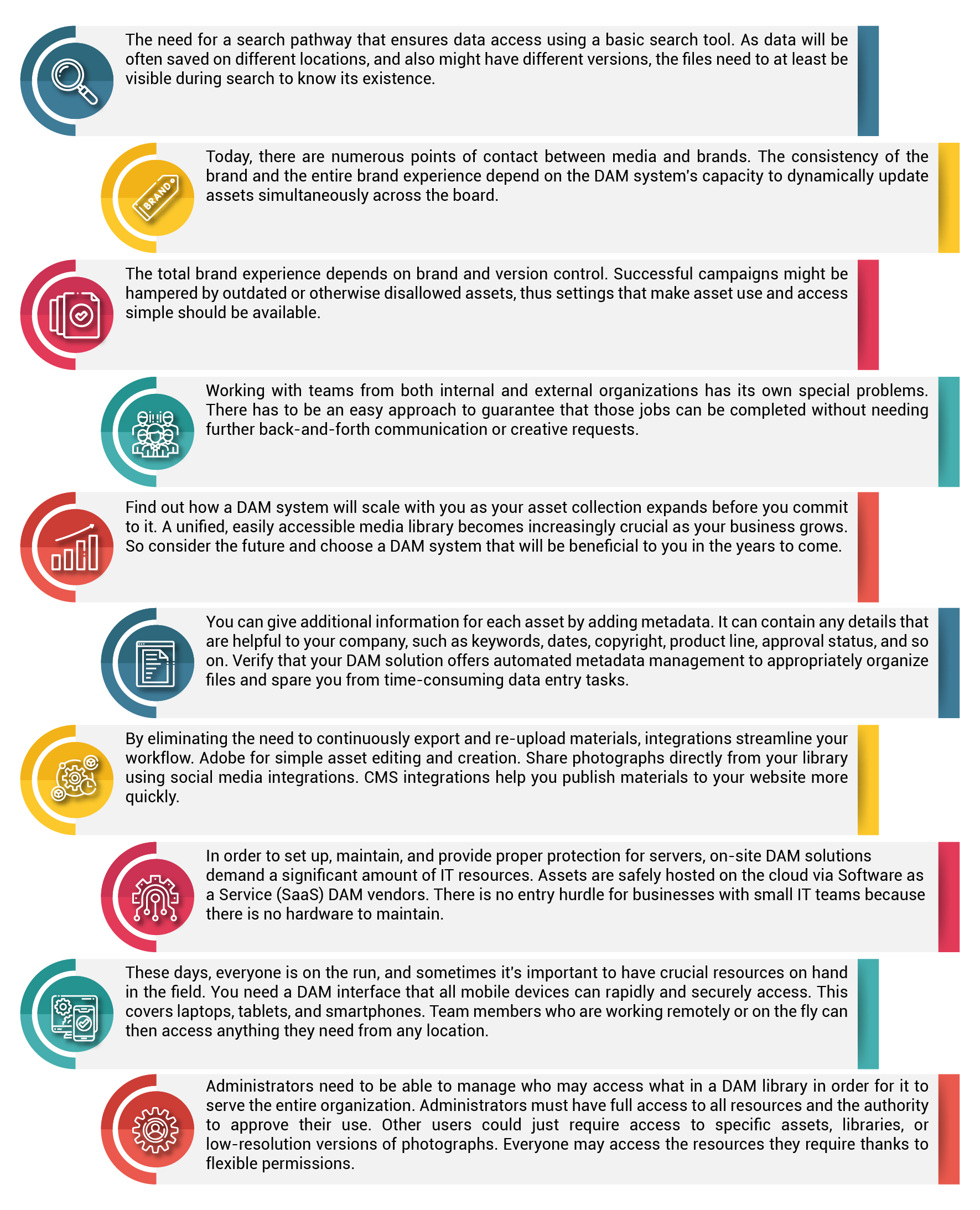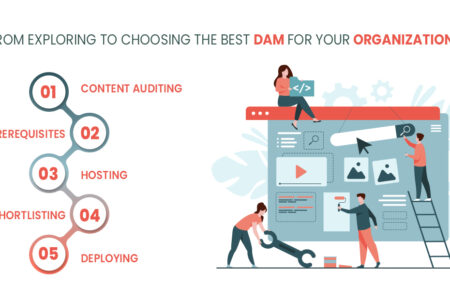Revisiting The Good Ole Digital Asset Management!
Your entire digital portfolio in one location! A digital asset management system is all about doing this. As already discussed in a previous article, DAMS is the treasure trove for your digital assets such as images, videos, and other files. The requirements for managing media assets, particularly photos and videos, have grown along with marketing over the past few decades, necessitating technology for storage or, more crucially, for dynamic optimization. These days, utilizing a digital asset management (DAM) system is a must for all modern enterprises.
Asana, for instance, studied the attitudes and behaviors of 10,223 knowledge workers across 5 nations in-depth to determine how their work time was split across various tasks. It was shown that almost 55% of the average marketer’s time at work is spent on activities like reacting to continuous emails and message notifications, attending unforeseen meetings, and hounding individuals for input or feedback.

The current digital media boom is being fueled by a number of trends and innovations, including low-cost, highly functional digital still and video cameras, increased network bandwidth, lower storage costs, low-cost, high-performance processors, high-capacity solid-state memory, reasonably priced cloud services, and the necessary digital media infrastructure.
We interact with and consume photographs, audio files, video clips, animations, games, interactive advertisements, streaming movies, and even experiential marketing, which has become more digital with the emergence of virtual reality and augmented reality. It is essential that we manage this content in a market that is so content-driven. The same content item could be needed by many teams in an organization for editing, updating, developing, or even marketing.
Getting Started With Your DAM!
You must understand the current state of your asset management, the hurdles teams and employees are encountering, how it affects their workflow, and how much time and money are allocated to asset development and upkeep before deciding which digital asset management software to use. You may better understand the complexities and effects of inadequate asset management through being aware of this, which will also assist you in making decisions.
The Eureka moment of realization does not completely fulfill the need for a DAM. Organizations must understand several facets and ask pointed questions before they decide on one. Some of the important questions to keep in mind in such scenarios are:

DAM-ming Your Organization
Huge digital asset files are becoming a growing issue for companies and brands all over the world. The methods and formats used to reach audiences have expanded in variety and sophistication. Building a brand experience that regularly reaches people through those channels is therefore crucial to achieving overall company goals. In order to properly manage these growing digital assets, brands are turning to a DAM system.
Content Auditing Digital Assets
Conducting a thorough assessment of your content and digital assets is the first step in selecting a digital asset management solution. You may better understand the types of material you have by conducting an audit, which will also show you how to reuse good content and weed out underperforming or irrelevant assets.
Following the completion of your audit, you should create a plan that takes your company’s goals as well as your content strategy into account. Consider the platforms for which you want to produce content, such as YouTube, your business’ website, mobile apps, Snapchat, podcasts, Instagram, etc. Next, decide what kinds of assets you’ll require to make that happen, such as photos, infographics, audio files, etc., and decide which languages and geographical areas you need to support.
You’ll be able to create an executable roadmap and be prepared to carry out your content strategy once your digital asset management system is in place by updating your content catalog and determining the gaps in your inventory.
Knowing Your DAM Prerequisites
To ensure that the DAM solution you select will be the ideal one for your business model, infrastructure, and users, identifying your system needs is a crucial step.
1. Tech Integration :
2. Asset Control:
3. Compliance Concerns:
4. Automation:
Classify Your DAM Hosting Needs
You can choose between a cloud-based, hybrid (a mix of on- and off-premise), or on-premises DAM system depending on whether you’ll need to expand dramatically up or down in the future, your available IT resources, and your financial constraints. DAM software functionality is important, but the solution you choose must also be technically feasible and tailored to your needs.
With on-site software, you can maintain complete control over the tool, including your choice of updates, resource security, backup and restoration management, etc. Additionally, it may be used without an Internet connection, which is helpful if you don’t have one or if you want to keep your platform as isolated from the outside network as possible.
Since there is no infrastructure to provide, a cloud-based software is easier and quicker to adopt. It is expandable and gives users the option to add services, receive free upgrades on a regular basis, or add more storage space as required. As long as the user has an internet connection and the necessary authorization, it can theoretically be accessed from anywhere and by anybody.
This design combines the two, allowing the program to be operational on-premises with cloud storage, or vice versa. You can choose what to maintain on premises and what to save in the cloud depending on your organizational needs.
Shortlisting DAM Options
There are many different digital asset management platforms available, and you must take the users, administrators, and business into account. You must make this investment valuable because it will take time to pay off. You will be forced to start over if you create a system that no one will utilize. Map out your DAM alternatives and establish a comparison of who you want to take a closer look at before you choose your system.
Numerous suppliers offer the same kind of technology and functionality. Perhaps in the end, it all comes down to pricing. More than just a file archive or image bank can be found in a comprehensive digital asset management system. Consider tying your assets to digital planning software, brand standards, your website, PIM, CRM, or an online store.
It’s time to learn the specifics now that you have all of your selections in front of you. It is simple to return to price if capabilities, features, and even integrations remain the same. A digital asset management system will benefit the entire organization, so you need to be sure you have everyone’s best interests in mind. Nothing is worse than spending money on a system that nobody will use.
Finalizing and Deploying DAM
Use an evaluation scorecard to compare the suppliers on your short list to the standards you’ve decided are essential for your team’s needs and your vision. To further limit the field, use references, unbiased analyst reports, or product reviews. To create a list of finalist contenders, several non-product characteristics, such as firm size and geography, can also be taken into account.
Once you have gone through the purchasing process, ensure a proper installation and tech support till your employees are well versed with the process.
Conclusively
No matter the sector or target audience in today’s digital economy, DAMs must be created with the needs of the digital business environment in mind. Regardless of the type of organization, contemporary and digital-first DAMs assist in delivering more engaging experiences more quickly, at scale, and with an agility that permits transitions when necessary as digital needs change.
Read More: Digital Asset Management 101: Get Your DAM(N) Software!
